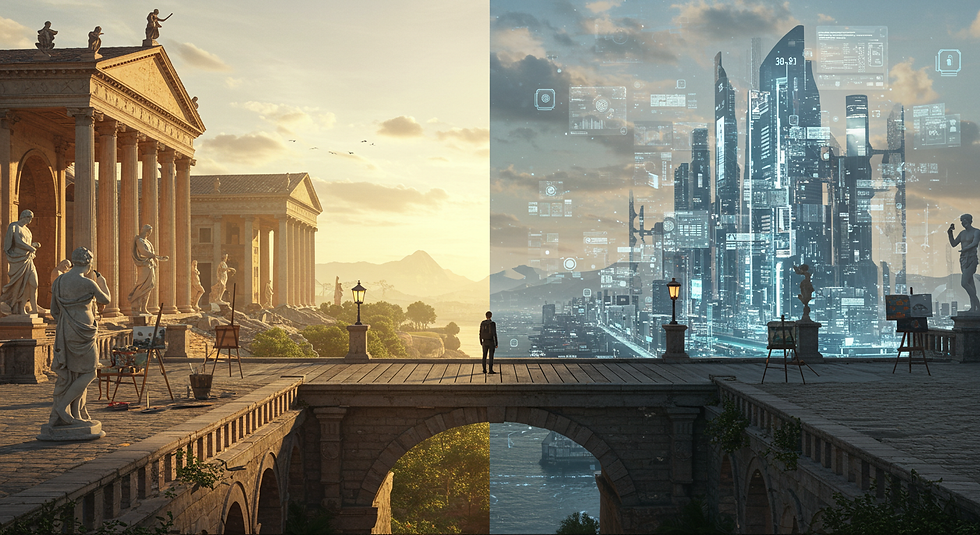AI and Ethics: Who Owns Creativity?
- Shahab Nn
- Sep 16
- 5 min read
In the last few months, I’ve been reflecting over whether AI and art can be good companions or is, in fact, destructive for artists. I kept talking with others, watching and by listening and, of course, asking AI itself. With the rapid advancement of Artificial Intelligence chat models (LLMs) and what we can now officially name the AI Race of nations (a modern Cold War), far deeper and vibrant replies are starting to take shape.
At first, I was suspicious of the whole AI thing and felt threatened as the AI was taking over my photography and artistic life. After that I started reading up on it, trying and discovering different models, how it works, etc. Over time, I even found myself turning into something of a pro-AI, a believer that AI could actually be the future of art, But then I slowed down and observed more. I realized that I am not completely on one side or the other, I’m somewhere in between.

But the main theme remains the same: AI is going to shape the future of humanity like never before and it is definitely the best, maybe the only way forward. Whether we like it or not, it’s already here. Look back in human history and you will always see innovation winning. Is there really a “loser” side? The simple answer is: likely not. Or better said, it depends..
So where does that leave us? It is likely somewhere in the middle, between admiring their generative power that wasn’t possible before, and being concerned about their ethical implications. We currently exist on the bridge between the world that humans created and the one that algorithms designed that we don’t quite understand.
As artists, we face an important choice: will we choose to fear the machine, or teach it how to feel?

The The Unfair Game: Taking Without Consent
When I talk about AI and art with artists who work in the creative field, I keep hearing the same thing. They say that AI is unethical because it steals human art.
Lots of artists share their artwork online and AI models are trained using such data to generate artifacts. A large part of this data is unauthorized extraction which is a big concern in the art world right now.
Let me start by saying, I’m genuinely glad to see artists care. They’re speaking up about this unethical use of their work. Whether it’s because AI companies are exploiting the situation or because artists didn’t foresee this outcome over the last few decades, the reality is, many were not cautious enough. They shared their work freely on social media and personal websites without thinking much about copyright, or how easily it could be collected through a smartphone camera in a gallery.
Now, to be clear: I’m not justifying the use of their data. Not at all. I’m simply saying: we’ve all had a role in this. So what now? What can we actually do?

Moving Beyond Blame
First, stop digging into an empty grave. Instead of only blaming AI, let’s take action.
How?
Start with how we use our smartphones. Be more mindful of where and how we publish our work.
Review our rights.
Push for governments to close legal loopholes.
And yes, governments can act fast when they want to. Take the UK, for example. They recently pressured Apple to reduce encryption protections under the name of "national security", essentially creating a backdoor to user data. Sounds wild, right? But it’s already happening. ( update; they back down due to US pressure (not for the sake of people just foreign policy)
So maybe updating laws isn’t as slow as we think.
Fairness and Transparency
The next step is clarifying what’s fair for all artists. I recommend checking out the DACS report and their suggested solutions for artists. These discussions are essential because they shift the conversation from fear into concrete solutions.
Last but not least: we need to understand how AI models actually work. Only then can we trace the issue back to datasets, because that’s where the models are trained. Many of them share the same data sources. Some claim to use only public-domain or freely licensed material, while others aren’t so clear about it.
If we identify and separate the good actors from the shady ones, we can better decide who deserves our support and who doesn’t.
The Big Question
One last question I keep coming back to:
If AI companies hired artists or paid them fairly for their contributions to training data, would the art community accept AI-generated art?
What if artists were paid to create works in the style of others, as a way to resolve copyright issues? Would that be more acceptable?
Especially now that tools like GPT-based image generators can turn your selfie into a Ghibli-style illustration in seconds, is it ethical, or is it imitation?
These aren’t easy questions, but they are necessary ones. If nothing else, they remind us that art and technology have always existed in tension. And maybe the real challenge isn’t choosing sides, but finding new ways to protect creativity while embracing the tools that are already shaping our future.



Comments